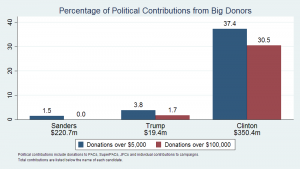The presumptive Democratic nominee has raised 30.5 percent of her campaign contributions from donors who gave more than $100,000. Donald Trump, on the other hand, got 3.8 percent percent of his contributions from large donors.
The financial woes of Donald Trump’s presidential campaign have been well documented in recent weeks. Federal Election Commission filings released this week showed a widening fundraising gap between the two presumptive nominees: while Trump raised slightly more than $4 million in May (including super PACs), the month after he effectively became the Republican Party’s presumptive nominee, Hillary Clinton raised $27 million.
The latest update of the Campaign Financing Capture Index—a Stigler Center project that tracks the attempts of large political contributors to affect public policy by focusing on the fraction of total funds raised from large donors—demonstrates the extent of Clinton’s fundraising prowess, particularly among large donors.
According to the most recent data, Hillary Clinton’s campaign, along with PACs, super PACs and joint fundraising committees that support it, raised $350.4 million as of May 31. Of those contributions, 37.4 percent came from donors who gave over $5,000, and 30.5 percent came from donors who gave more than $100,000.
Donald Trump’s campaign, on the other hand, along with PACs and super PACs that support it, raised only $19.4 million as of May 31. $12.7 million of those contributions came from donors who gave less than $200. When it comes to big donors, Trump received only 3.8 percent of his contributions from donors who gave over $5,000 and 1.7 percent from donors who gave more than $100,000. Trump has largely self-financed his campaign so far, loaning it $46.1 million since the beginning of the race. (A loan he has since forgiven).
Clinton’s main super PAC, Priorities USA Action, raised $8.6 million in May, of which an overwhelming $8.3 million came from contributions of at least $100,000. Its largest contribution in May came from Chicago media mogul and major Democratic donor Fred Eychaner, who gave the pro-Clinton Super PAC $3 million. Financier Donald Sussman donated $2 million to Priorities USA Action in May, after already committing $1.5 million in March. Investor Bernard Schwartz also gave $1 million.
Trump’s main super PAC, Great America PAC, raised only $1.4 million in May. The biggest donations were an in-kind contribution of $83,000 from a company called Rapid Response Television and $50,000 from private equity energy investor Douglas Kimmelman. The pro-Trump super PAC received two other large contributions, one of them a $25,000 contribution from billionaire Stanley Hubbard, a former backer of the anti-Trump movement.
Democratic candidate Bernie Sanders, who effectively lost the race to become the Democratic nominee earlier this month, remained on the low end of the index in May. Since the beginning of his campaign in April 2015, Sanders has only received 1.5 percent of his $220.7 million in campaign contributions from donations above $5,000 and received no contributions above $100,000.
The Campaign Financing Capture Index, launched in March, analyzes the distribution of political contributions to presidential candidates and takes into account individual contributions and contributions made to the PACs, super PACs, and joint fundraising committees that support each candidate. It is our belief that large political contributions represent more than the mere expression of political preference and are more likely meant to influence policy in favor of the donor’s interest. When the percentage of funds raised from large donors is increasingly significant, as it has been in recent years, this problem becomes acute.
The analysis was done based on data collected from the FEC website, and comprises individual contributions made to campaigns, main super PACs, PACs, and JFCs since the beginning of the race until May 31. The Stigler Center will publish a concentration and distribution analysis every three months until the presidential elections.







